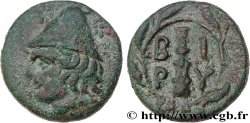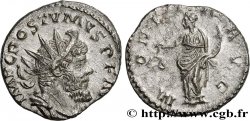v16_0657 - AURELIAN Antoninien
MONNAIES 16 (2002)
Starting price : 160.00 €
Estimate : 500.00 €
unsold lot
Starting price : 160.00 €
Estimate : 500.00 €
unsold lot
Type : Antoninien
Date: été 271
Mint name / Town : Thrace, Serdica (Sofia)
Metal : billon
Millesimal fineness : + 20 ‰
Diameter : 20 mm
Orientation dies : 12 h.
Weight : 3,32 g.
Rarity : UNIQUE
Officine: 2e
Emission: 1re
Coments on the condition:
Beau portrait expressif. Patine noire
Catalogue references :
Obverse
Obverse legend : IMP AVRELIANVS AVG.
Obverse description : Buste d’Aurélien, tête radiée, à droite, avec cuirasse et paludamentum, vu de trois quarts en avant (A).
Obverse translation : “Imperator Aurelianus Augustus” (L’empereur Aurélien auguste).
Reverse
Reverse legend : CONSERVATORI// S.
Reverse description : Esculape debout de face, regardant à gauche, tenant de la main droite un bâton autour duquel est enlacé un serpent et tenant sa toge de la main gauche.
Reverse translation : “Conservatori” (Au protecteur).
Commentary
Semble complètement inédit et non répertorié.








 Report a mistake
Report a mistake Print the page
Print the page Share my selection
Share my selection Ask a question
Ask a question Consign / sell
Consign / sell
 Full data
Full data














